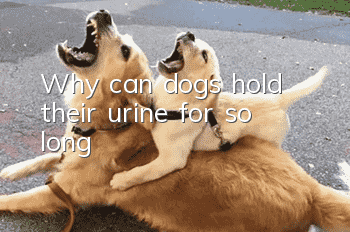Dog postpartum care is a top priority and cannot be ignored!

They say that giving birth is one foot at the gate of hell, while the other foot is lingering and hesitating at the door. Many unmarried girls maintain a wait-and-see attitude towards childbirth, and even gave birth to the DINK clan. Indeed, giving birth will consume all the energy and nutrients, and the postpartum care must not be sloppy. If you are not careful, you will have postpartum sequelae, postpartum complications, etc.
Dog delivery is no different. Postpartum female dogs are exhausted, dehydrated, in pain, and even lose interest in food... ...
Normal postpartum phenomena
· Sleep
After giving birth, a female dog will sleep for a few hours due to fatigue, longer than usual; although this is normal, parents also need to pay attention to her restlessness/discomfort.
· Diarrhea
Ingestion of the placenta/emotional stress can cause diarrhea in dogs after delivery, which is normal behavior; it is recommended to feed some pumpkin puree to help improve it.
· Loss of appetite
A female dog will be very tired after giving birth and will not eat immediately. If she has not eaten within 24 hours, please contact your doctor immediately for help.
· Continuous discharge of secretions
It is normal for a female dog to discharge secretions from the vaginal area for several weeks after giving birth, but the color of the secretions should be brown; black/red/green, accompanied by a foul odor, indicating that she is infected and needs to consult a doctor immediately Ask for help.
· Out of breath
After giving birth, the female dog may be out of breath due to uterine contractions/other pains, so don’t be nervous. If it is accompanied by other symptoms such as fever, vomiting, etc., it should be taken seriously.
Note: The female dog did not pant after giving birth, but was in good spirits, so parents do not need to be nervous.
Bitch care
·Nursery cleaning
When the female dog leaves the nursery to defecate, she can take away the dirt produced during the delivery process and replace it with clean supplies (regular replacement) to keep the area clean and reduce the risk of infection.
· Female dog hygiene
Use warm water to wipe the body (vulva, breasts, tail), secretions, placental fluid, blood stains, etc.Keep the body clean and clean; the female dog can only take a bath after her condition is stable for two weeks (remember to measure the female dog’s body temperature after taking a bath).
· Adequate moisture (warm water)
A female dog will be dehydrated after giving birth and will need a lot of water to help her recover and produce milk. Make sure she has adequate water during lactation. (The female dog is unwilling to drink water, so it is recommended to feed her some chicken soup)
· Food Supplies
Female dogs that have just given birth and have poor appetite can be fed easily digestible and high-quality nutrients (such as milk, wheat flour, etc.). Gradually increase the food after 4 days, and return to normal after 1 week. Female dogs during lactation should increase the amount of food they feed (preferably provide food every three hours), ensure sufficient breast milk, and feed fresh food (lean meat, chicken, bone meal, etc.) or high nutrients (nutritional paste, calcium tablets, cod liver oil, etc.).
Note: If the female dog shows little interest in the food provided within two days, it is recommended to receive help from the nearest hospital.
· Quiet environment
A female dog that has just given birth is still emotionally unstable. Do not let strangers approach her. This can prevent the female dog from feeling harassed, which may cause her to become nervous and cause harm to the puppies. She must be kept quiet for at least 8 to 24 hours.
If the situation permits, it is recommended that after the mother dog gives birth, she and her puppies be taken to the hospital for a full-body examination (to confirm the gender of the puppies) to ensure their health. In addition, if the puppies have difficulty moving, you should always pay attention to prevent the mother dog from accidentally crushing the puppies. If you hear the puppies screaming for a short time, you should go there immediately.
Postpartum complications
· Eclampsia/milk fever/hypocalcemia
It usually occurs during the first three weeks after giving birth because the body cannot meet the demand for calcium during milk production, but it will not affect the puppies. Generally, small dogs are at a higher risk than large dogs.
restless
Lack of interest in puppies
Stiff gait and difficulty standing
Muscle spasms
Fever, wheezing
Shortness of breath, epilepsy
Note: If intravenous injection is not given in time, eclampsia can be life-threatening; puppies need other feeding products instead.
·Metritis
There are many triggers, such as the use of instruments to assist delivery and the difficult delivery process, which may cause infection. If the placenta or fetus remains in the belly of a female dog, it is more likely to cause sepsis. If a puppy sucksConsuming breast milk can cause food poisoning.
Fever, dehydration, lethargy
Loss of appetite, vomiting, diarrhea
Panting and rapid heart rate
Purulent (foul-smelling, red/chocolate-colored) vaginal discharge
Note: Treatment of this type of disease requires antibiotics; puppies need to be hand-fed.
· Mastitis
Breast infection disease, red and inflamed. It may be caused by scratching the mother dog's nipples with her nails while the puppies are sucking.
Nipples are swollen and hard
Fever, pain
Breast milk heterochromia
Neglecting Puppies
Puppies cry (no weight gain later)
Note: It can be cured with antibiotics and hot compresses. If abscess/gangrene develops it may be life-threatening, seek medical help immediately; puppies will need to be hand-fed.
· Preserve placenta
Symptoms may appear immediately or after a few days due to the residual placenta/puppy in the abdomen.
Continuous vomiting and dehydration
Loss of appetite
Discharge green discharge
Note: If this happens, please seek medical help immediately.
If the bitch bleeds heavily or bites/swallows the puppies, she needs to seek medical help immediately. If the bitch hurts the puppies, it is best not to breed again. Neutering is the best solution. In addition, parents need to always pay attention to the nursing situation of the mother dog during the lactation period, such as the mother dog not breastfeeding the puppies, low milk production, etc.
Note:
· If the mother dog refuses to stay with the puppies, you can try to relocate the nursery and force the mother dog to stay with the puppies. This can force the puppies to scream and stimulate the mother dog's maternal nature.
· Female dogs that give birth for the first time are relatively anxious and usually choose a hidden/dark place to prevent the puppies from being overly exposed to view. (Small closed boxes can help solve this problem)
· Trim puppies' nails regularly to avoid scratching the mother dog's breasts, which may cause infection and cause disease problems
· Lactating female dogs will defecate frequently due to their excessive diet, and their feces will be soft in the first few days
· The female dog is reluctant to leave the puppies at first, and it is the parent’s responsibility to encourage her to urinate/defecate normally
· Lactating female dogs will shed a lot of hair. Parents should comb them in time. If you see bald spots, please contact the doctor in time
· Mother dogs feed vomit to puppies to help the weaned puppies transition to diet (soaked dog food, etc.)
- Feeding tips for adult dogs
- Why does a dog’s tongue turn white?
- Reasons why dogs hunch their backs
- Is a Border Collie sick because his nose is dry? What are the reasons for a dry nose in Border Collies?
- The Border Collie's paws are very hot. Does he have a fever?
- If your dog shows these 10 symptoms, it may be a health problem!
- These 4 behaviors of dogs are because they want their owners to play with them!
- Dogs’ ear canals need to be cleaned regularly and kept dry. How should you clean your dog’s ear canals?
- Can a one month old dog be bathed?
- Food you can safely share with your dog



